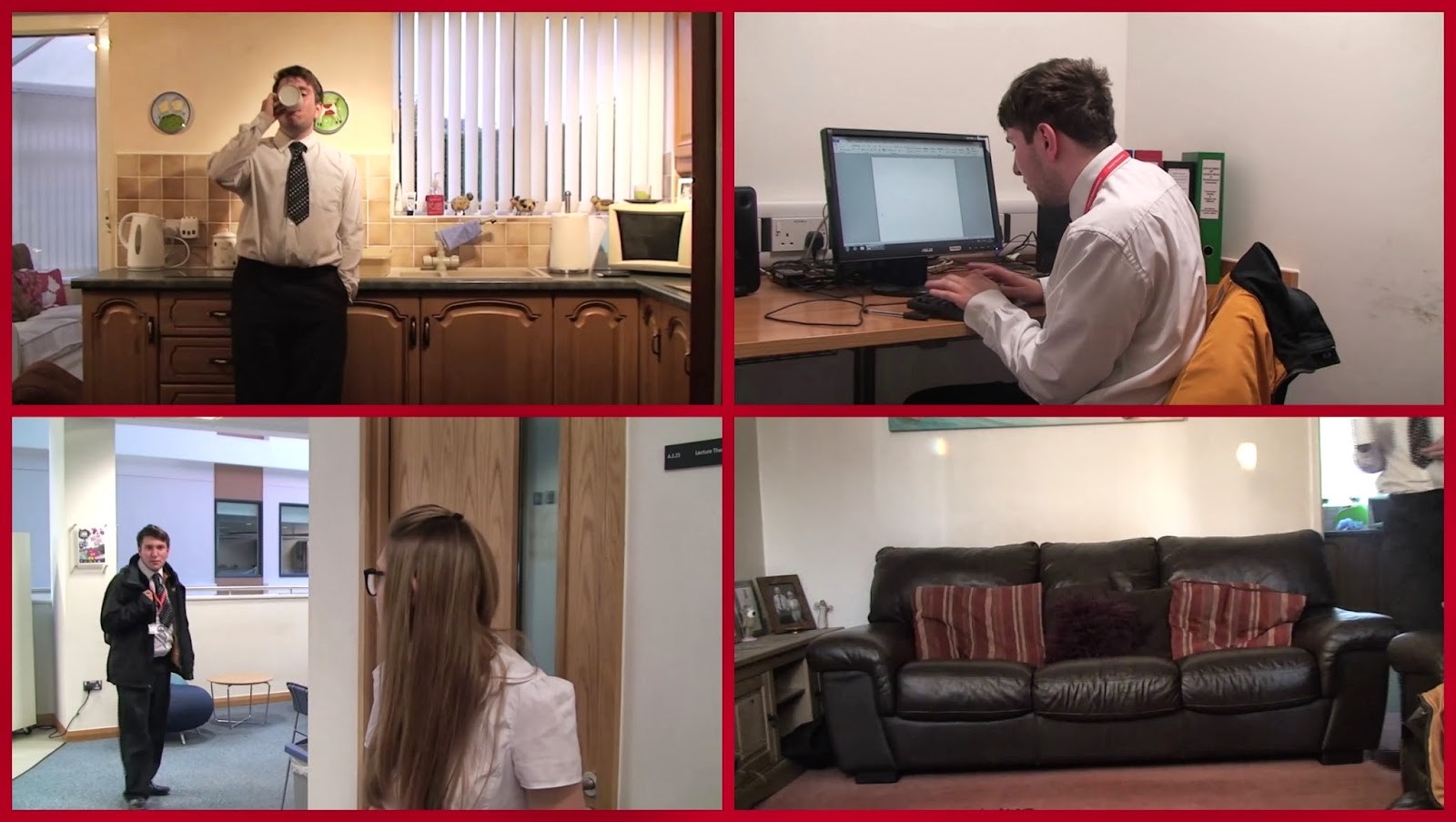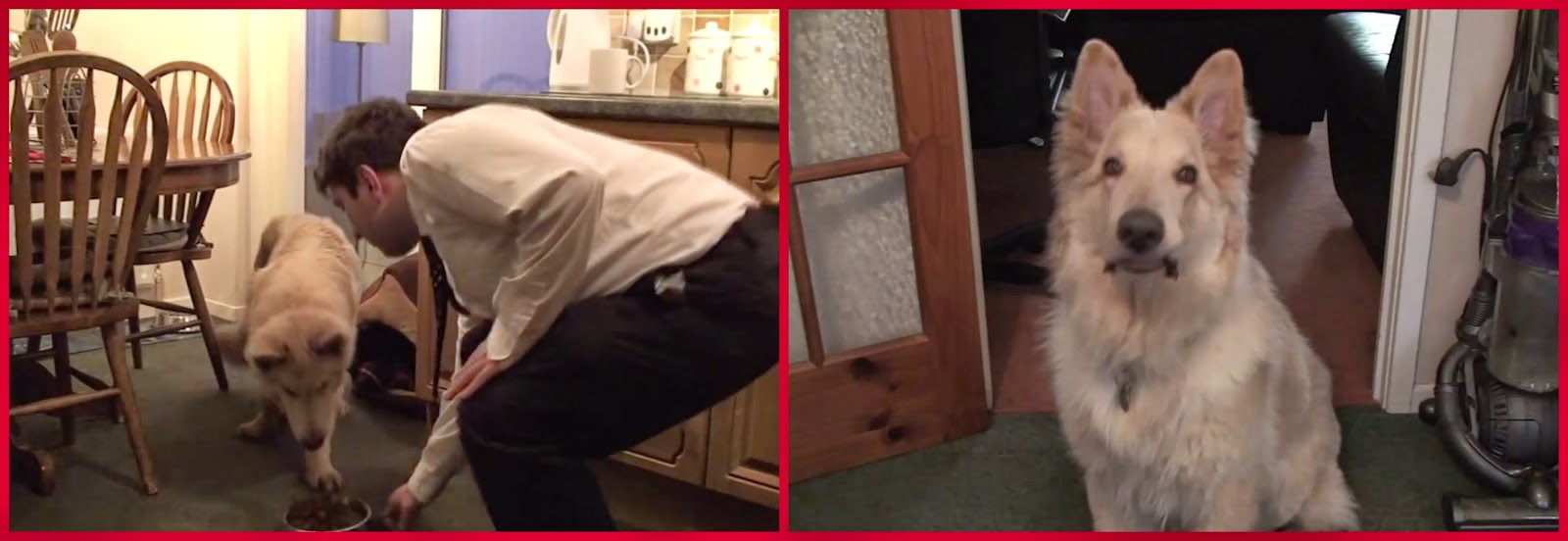1. In what ways does the media product use, develop or challenge forms and conventions of real media products?
As a Physiological Thriller, our film follows a number of conventions to attract the right audience, and achieve the reviews we aim for. 'A Truncated Parable of Complete Normality' mainly follows conventions of thriller, but the use of existential realisation and the idea of living in a virtual reality adds a more physiological theme to the whole film. As short films have a limited time, we obviously followed an almost 'standardised template' when producing the shot list, and by watching other short sketches and films, we settled on the plot and main themes of the film. We used Sci-Fi elements in our film, however chose against making these themes the main genre.
In terms of filming, we kept close to generic shots in order to clearly state certain parts of the films plot. As we have a complicated storyline, using simple shot reverse shots and sticking to a 180 Degree rule is essential to keeping our audience interested in the film and up to date with everything that develops through out. In an attempt to keep the true nature of our film a secret, typical shots will ensure our protagonists life looks as normal and regular as possible.
In order to keep the audience familiar with certain places, such as Davids home compared to his office, we used establishing shots whenever the location changed. The first few shots are short and sharp, in order to repeat the scene as many times as needed without wasting screen time. Creating a sense of repetition is key to the plot, so we need to make our audience feel bored, almost, sympathising with Davids uneventful life. The audience will also be given the impression that our protagonist is rushing when the shots are short, and that he is absent minded during the long scenes. For the most part of our film, we used longer shots, varying every scene in order to quicken and slow down the pace of the short. Where simple tasks take place, such as making a cup of tea and ending the alarm clock’s signal, we stuck to quick paced shots, as not much detail was needed, seeing someone simply boil a kettle and pour the water into a mug would tell the audience what David is doing, as does the alarm clock inform them of the time of day. The juxtaposed elements of traditional scenes and short, snappy jump cuts show an experimentation of pace and difference in Davids attitude, avoiding serenity.
Close ups and cut ins show our protagonist in normal, everyday circumstances, again, persuading the audience the film just follows the repetitive life of David. As David opens his office door, the film cuts to a close of of him fiddling with his keys and struggling to get in, giving the audience a relatable subject to focus on, and, yet again, creating a sense of normality. Close ups were also useful in showing characters reactions and facial expressions, relaying these to those watching and possibly making them feel the same. When hearing a strange glitchy noise, David's face is shown looking confused, breaking away from previous normalcy. This is where the film begins to take a turn, so showing certain expressions through the use of close ups tells the audience something isn't right.
The pace of our film needed to keep the audience interested, as well as making Davids life seem dull. By quickening the pace of the film with short shots, we were able break up any longer scenes and have a smooth transition into establishing the location of David, as did long shots keep the plot neutral and uninteresting. This process lengthened the time it took to edit, but as seen in Office Space, our inspiration, and the results we saw in our final film, showed to be effective. Taking this idea from Office space meant the repetitive nature of Davids was show clearly to the audience, along side the acting and attitude of our protagonist.
When writing the shot list, we decided to experiment with high and low angled shots. By showing Tim from Davids eye level looking down on him, it not only indicates their height difference, but subtly suggests David’s power over him. As Tim’s owner, David would obviously have control over what he does, but having Tim manipulate David into feeding him when he may not necessarily be due a meal, and taking him out for a walk when Tim wants, foreshadows Davids lack of control. These angles were mainly used, however, to show a realistic height difference between David and Tim. By having Tim look directly into the lens, as the camera is where David is stood, and then having Davis look directly into the lens as if it is Tim made the whole scenario look both comical and authentic, the point-of-view shots hopefully making the audience forget they were watching a film with camera’s and begin to feel engrossed by the two characters.
Working with animals was expected to be rather difficult, and we had chosen to decide on a back up shot list incase Tim didn’t do as instructed. Unfortunately, we he'd become rather set on involving Tim, so chose to only choose after filming what would take the place of Tim’s scenes, however with the aid of cocktail sausages, and Tim’s trained ears meant we were able to gain shots that were suitable. This did mean rather a lot of editing was needed in order to fins the right shot, but we found one none the less.
When it is revealed that David is being controlled by someone playing his life as a video game, we chose a crane show to start the transition from Davids virtual reality into our teenager’s reality. Switching from David to Louise’s made all of the previous glitches make sense, as well as making everything clear to the audience. I feel that the use of high and low angle shots helped to achieve this sense of surprise, by creating a reality that doesn't seem virtual.
Our film was created, originally, as a source of entertainment, but as filming commenced, we realised that it could lead to a deeper meaning. Seeing David live a mundane and pitiful life may make people watch the film and relate their lives to his. This could lead to audience members learning from his mistakes, and choosing to not change his life for the better. Entertainment seemed to be the main audience pleasure we were aiming to provide, as with David losing control over his life could lead to the belief that we aren’t in control of our own lives either. This concept could work in our favour, however, as this could be seen as a modern interpretation of the Christian belief of an all-seeing God, again relating back to the idea of using the film as a moral lesson. The thrill of finding out that the character whose life you have become so attached to during the majority of the film is in fact not real, and that David is unaware of this fact, makes the audience sympathise even more with him.
Struggling to fit the plot into one genre, we defined our film’s story line as a mixture of two, naming it as a Psychological Thriller. Constantly challenging Davids existential thoughts also challenged the audience’s, by making the character relatable. Relating to someone who is unknowingly trapped in a virtual fantasy could lead them to question their existence, emphasising the psychology of its characters and their unstable emotional states. The cliffhanger and the intense score, coupled with David being completely oblivious also made it a thrilling film to watch.
Dyers there of representation suggests that two people from different backgrounds, who are into two different things, have different jobs etc. means they are completely different. Stereotypes are usually exaggerated in films to get the producers point across to the audience clearly, for example, to indicate a male character is gay, they may act more flamboyant that the straight characters along side them, when in reality, being flamboyant and gay are two completely different things. Our film includes no strong stereotypes, but does, however, show differences in how characters interact with each other. For example, the two coworkers introduced in Davids building constantly converse as David walks by, and seem to be rather fond of each other’s company, however the way they talk to David insinuates a slight annoyance. Having David not smile and barely acknowledge the women as he walks by may lead the audience to assume they are constantly talking to each other, and rarely include David in their daily topic. This could be seen as a stereotype, as women are notorious for being spitefully critical, however David isolation could counter act this behaviour, indicating he is intact the reason they don't speak.
Over all, I am pleased with our outcome. We were able to develop on common forms and conventions of the genre we chose to identify our film as through thorough research and were inspired by real media products such as Office Space. Many conventions of a Psychological thriller depend on the storyline of the film, and whether it fits the plot, so avoiding some conventions would have been inevitable, however the themes of mental imprisonment and identity were strong influences on how our film was organised.






No comments:
Post a Comment